What worlds can survive the death of the sun?
- Transfer
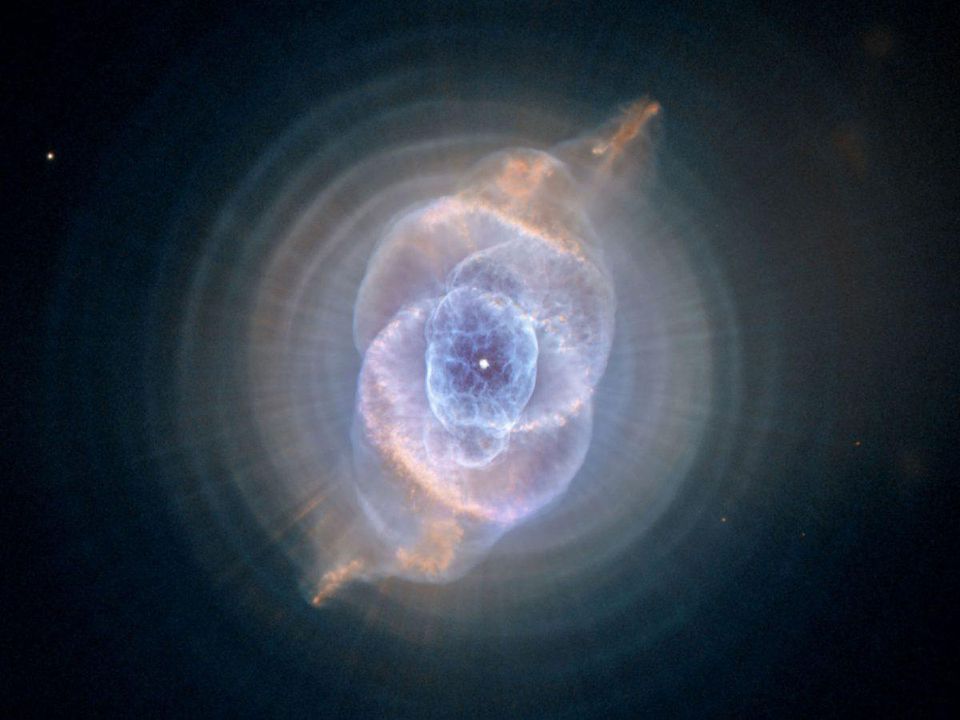
When our Sun runs out of fuel, it will become a red giant, and then turn into a planetary nebula with a white dwarf in the center. The Cat's Eye Nebula is a magnificent and colorful example of this possible fate, and the intricate, multi-layered and asymmetrical shape of this nebula indicates the possible presence of a companion star.
Nothing on Earth is eternal, and this truth extends even to those objects that we see in our sky. The sun, which gives light and warmth to all the worlds of the solar system, will not shine forever. Now helium is synthesized from hydrogen in its core, with the result that with each nuclear reaction a small amount of mass is converted into pure energy, according to Einstein's E = mc 2 .
But this can not last forever, because the amount of fuel in the core is limited. The sun has already lost mass in this process, equivalent to the mass of Saturn, and in 5-7 billion years it will completely consume all fuel in the core. Having swelled to a red giant , it will eventually shed its outer layers, creating a planetary nebula , and its core will shrink and turn into a white dwarf . For the outside observer it will be a beautiful and colorful look. But inside the solar system this will lead to a catastrophe.
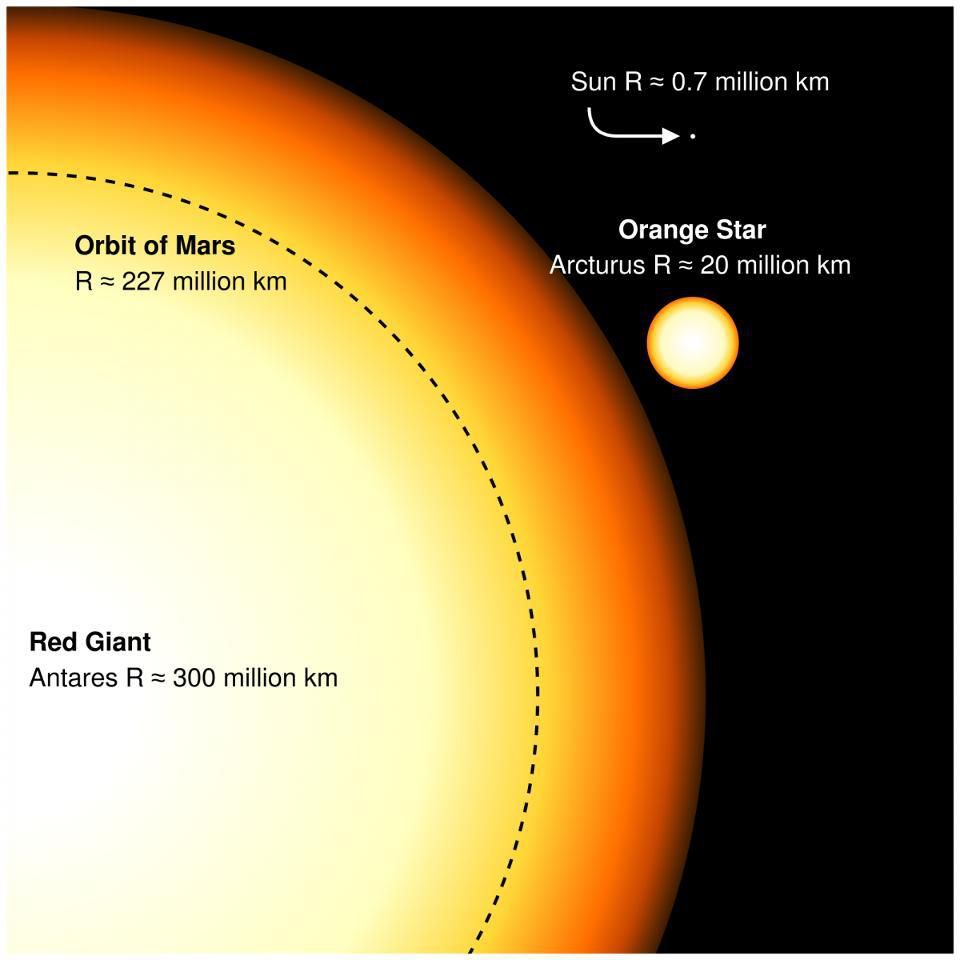
Today, the Sun has a very small size compared to giants, but it will grow to the size of Arcturus in its red giant phase, and will swell up to 250 times the current size. He will never grow to a monstrous giant like Antares .
The first thing you need to know about the red giants - they are huge. It seems to us that our Sun is large: 1.4 million km in diameter, with a mass of 300,000 times more than that of the Earth, however, compared to the red giant, this is nothing. With such a mass, our Sun will grow 100 times in comparison with the previous size, absorbing Mercury and Venus. The Earth is likely to be pushed further, during the growth and loss of mass by the Sun, and although it can be absorbed by a star, scientists are still arguing about whether it will survive or not.
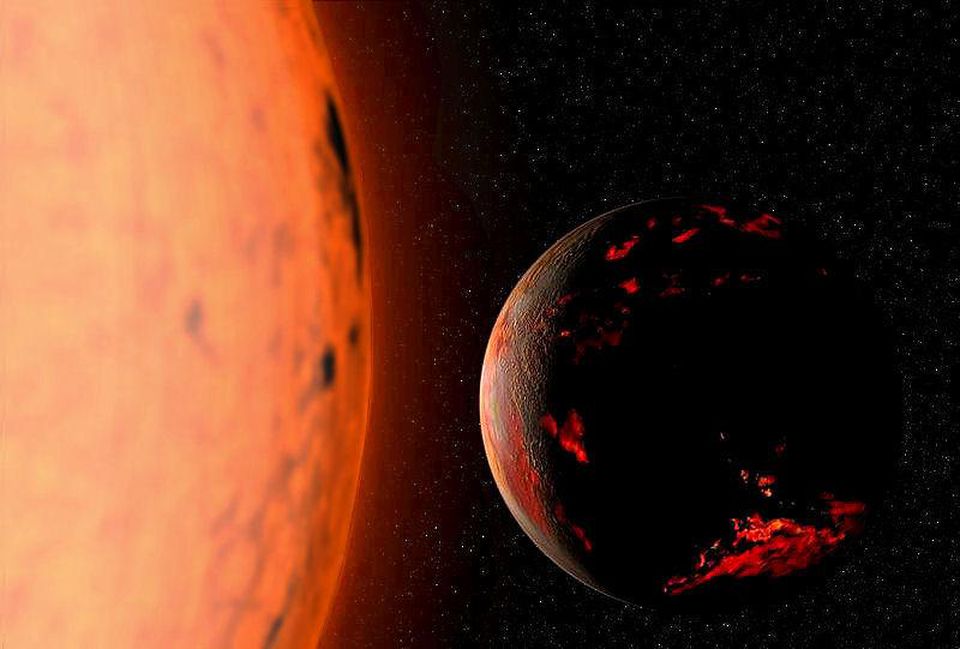
If the calculations are correct, the Sun will not have to absorb the Earth when it swells to a red giant. However, it will have to become very hot and undergo catastrophic changes.
In this case, the Earth and Mars will turn into charred, barren worlds. The oceans and atmospheres of these planets will boil and disappear from the surface, and these worlds will become airless and hot, like today's Mercury. These effects will extend far beyond the orbits of the inner rocky worlds of the solar system.
You see, the red giants are not just huge, they are also still warmed to many thousands of degrees, but shine a thousand times brighter than today's sun. Most of the material ejected — by mass, making up between a third and a half — will remain heated to extreme temperatures and reach the outer edges of our solar system. Asteroids will melt, losing all volatile components, and only rocky cores will remain from them.

There are some volatile components in asteroids, and they often exhibit tails as they approach the Sun. Over time, when the Sun grows to the red giant, these asteroids will melt, lose all volatile materials, and become either heaps of cobblestones or melted stones - in any case, becoming much smaller than the current sizes
But the gas giants will be massive enough to continue to hold their gas clothes, which may even grow when the sun enters this phase. For example, today we find only gas giants in orbit around the red giants, much larger than even Jupiter. Perhaps this is the result of selection - and we see them because they are easiest to see - but perhaps this is the result of an inevitable process.
Huge quantities of material leaving the Sun will collide with gigantic worlds with powerful gravitational fields. Much of the material that will meet with these atmospheres will emit a slap of cosmic proportions and increase the size and mass of these worlds. As a result, Jupiter, Saturn, Uranus and Neptune may turn out to be larger and more massive than today.

Visually, a large gap between the sizes of worlds of the Earth type and planets like Neptune is immediately apparent - and turning the Sun into a red giant will only increase this difference. Earth and Mars will lose the atmosphere, and, possibly, a part of the surface, with the gas giants growing up, absorbing more and more matter when the Sun drops the outer shell.
However, the sun will become so bright and hot that most of the outer solar system will be completely destroyed. Each of the gas giants has its own rings; Saturn's rings are best known, but all of our four giants have them. They mainly consist of various ices - water, methane and frozen carbon dioxide. Thanks to the extreme energy produced by the sun, these ices will not just melt - their individual molecules will acquire such energy that they will be thrown out of the solar system.
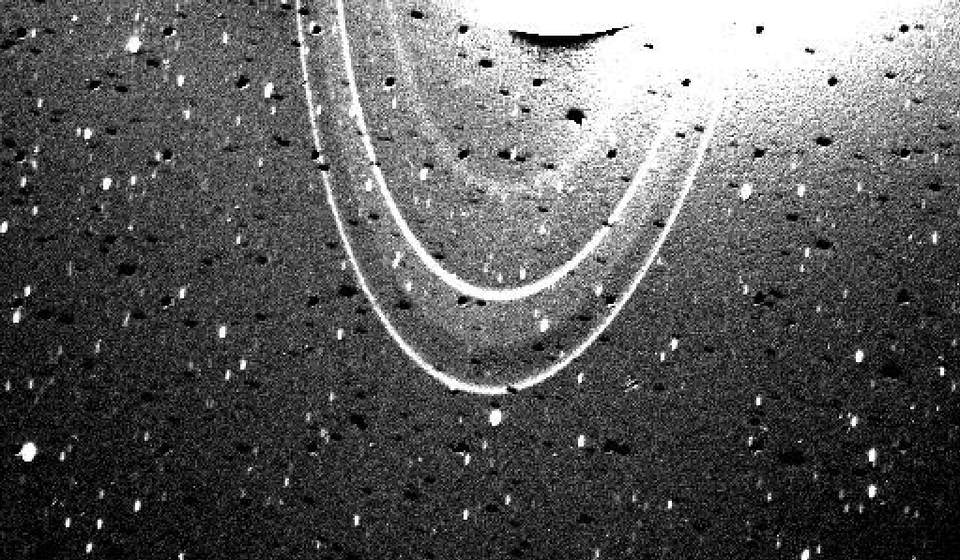
Neptune's rings, captured on a wide-angle camera Voyager-2 with a large exposure. You can see how continuous they are. Neptune's rings, like the rings of all gas giants, are made up of volatile ice components, and melt, boil and sublimate when the Sun turns into a red giant.
The same will be true for moons rich in water, revolving around these worlds. The frozen surface of Europe , under which there is water ice, will completely boil away. The same will happen with Enceladus , which will evaporate almost everything except the rocky core with an admixture of metals. Practically all the moons of Jupiter, Saturn, Uranus and Neptune will decrease significantly in size, their atmospheres will boil away, their outer layers will melt and disappear; Only the cores of these satellites consisting of stone and metal will remain. Some moons that are completely volatile may disappear completely.

Enceladus - Saturn's moon, almost entirely composed of water ice. A pillar of matter, erupting from it, indicates the presence of a large subsurface ocean, but the increased brightness of the Sun will lead to its boiling away, and will leave only the bare core.
Even the largest and well-known Kuiper belt objects are not protected from this trouble. Even worlds that are at such great distances as Triton , Eris, or Plutowill receive four times more energy per surface than the Earth receives today. Their atmospheres and surfaces, now covered with various types of ice, and possibly containing subsurface oceans, will also evaporate completely. When the Sun becomes a red giant, and the inner worlds turn into charred remains or are absorbed by the Sun, worlds like Pluto will not become potentially inhabited planets: they will burn. They will turn into bare cores of stone and metal, and will become similar to today's Mercury.
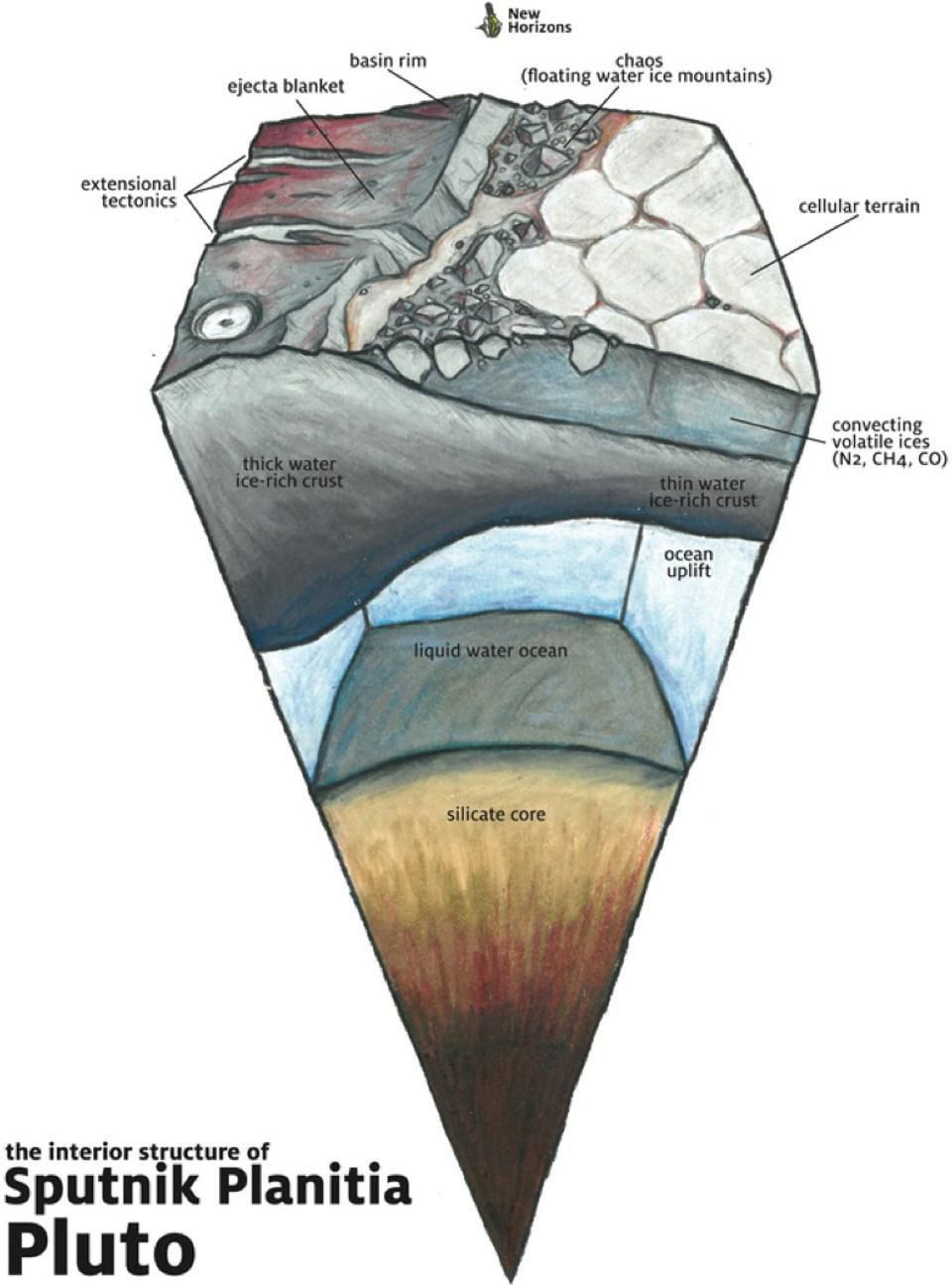
Geological structure below the surface of the plain of Sputnik . It is possible that on Pluto under the thin crust is an ocean of liquid water. When the Sun becomes a red giant, all the outer layers are sublimated and boiled away, leaving behind only a core of stone and metal.
A few tens or hundreds of millions of years will hope for the presence of more acceptable conditions on the Kuiper belt, at a distance of 80-100 times greater than the distance from the Sun to the Earth. For this small, by space standards, a period of time, objects at this distance will receive about the same amount of sunlight as Earth today receives. However, for the habitability of the world need something more than sunlight; you need to have enough mass, suitable size and appropriate ingredients. The moon and the Earth are very different in habitability, despite receiving almost identical amounts of solar energy per unit area.
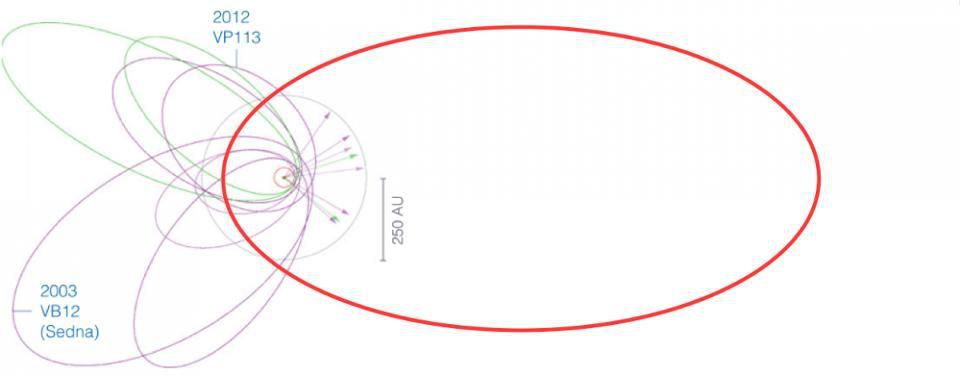
The orbits of the famous sednoids , along with the alleged Ninth Planet. Even when the Sun becomes a red giant, the Ninth Planet - whose existence is so controversial - will not reach a temperature sufficient to become potentially habitable. The other worlds of the Kuiper belt, even those that are at the right distance, will be too small from this point of view.
However, even the hypothetical Ninth Planet will be too far away to become potentially habitable, and everything that is at the right distance will be too small for life to exist there. The solar system will become a molten catastrophe, where only the bare cores of the planets, moons and other objects will remain. Gas giants may swell and grow, lose their rings and many satellites, but everything else will be nothing more than metal-rich pieces of garbage. If you hope that the frozen outer worlds of the solar system will finally get their chance to shine, you will be disappointed. When the Sun comes to the end of its life, these worlds, like our hopes for survival, will face the fact that all the most important things will melt and disappear.
More articles on the popular science topic can be found on the Golovanov.net website . Read: when dark matter and dark energy appeared ; is it possible to create life in the laboratory ; who will survive the death of the sun ; a series of articles on cosmology " Ask Ethan ".
I remind you that the project exists only thanks to the support of readers (bank cards, Yandex.Money, WebMoney, Bitcoins, and at least as). Thanks to everyone who has already provided support!
